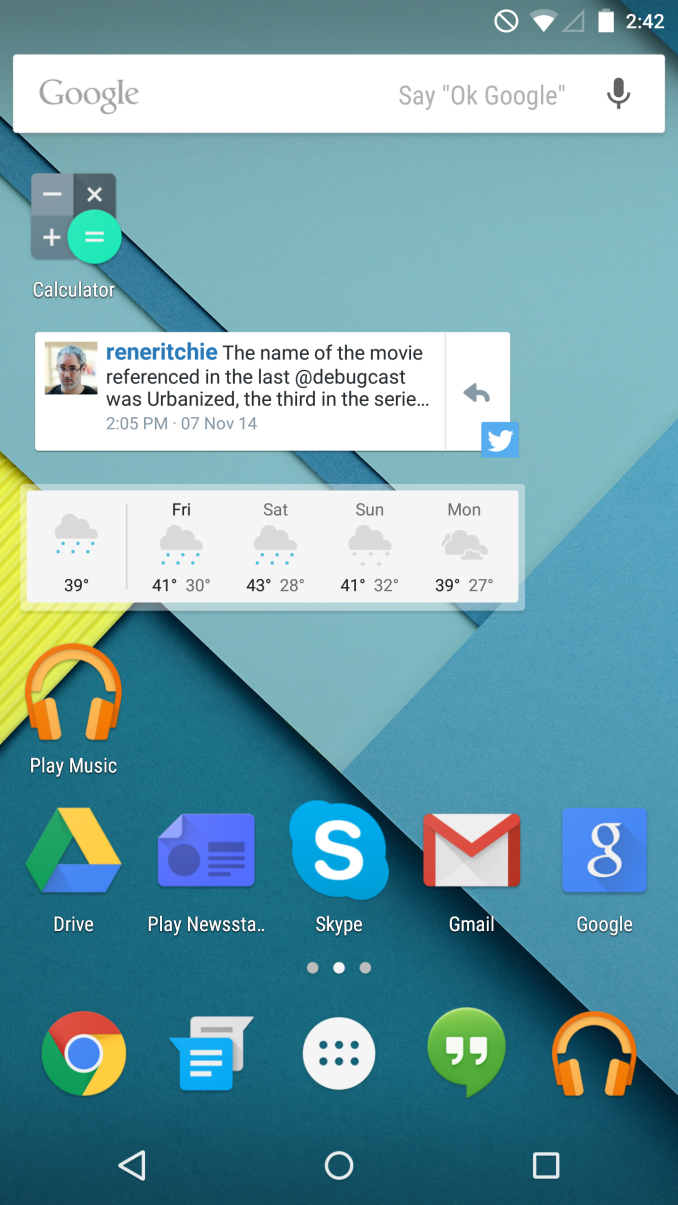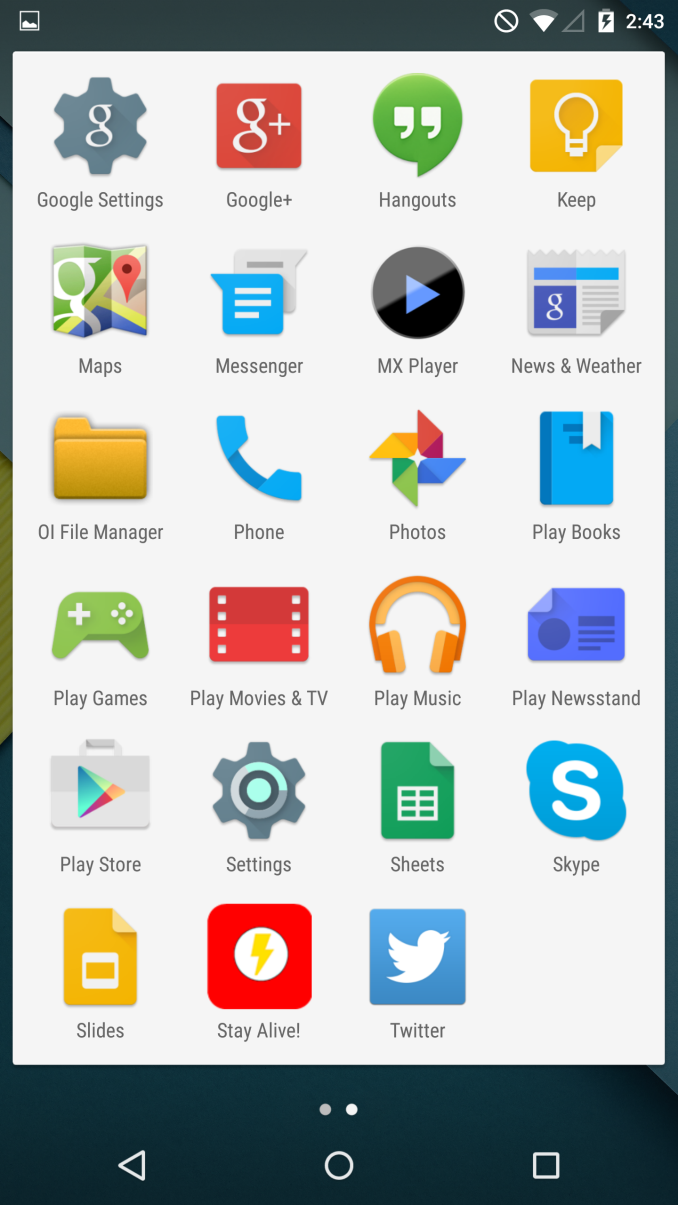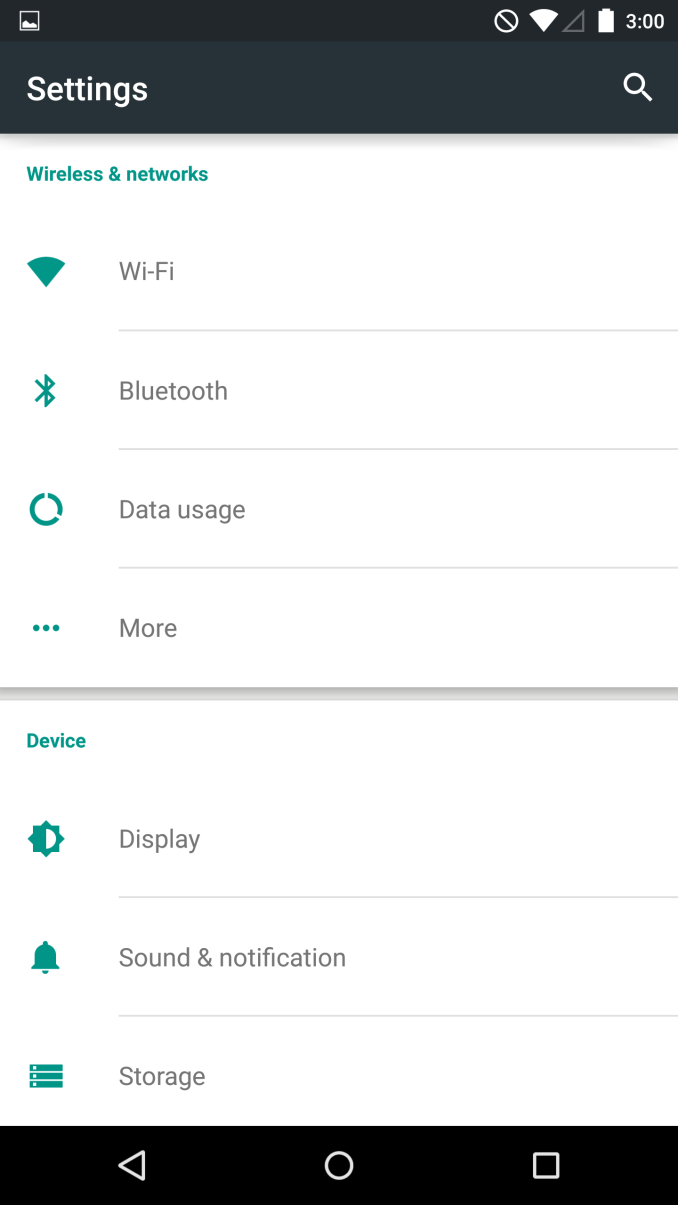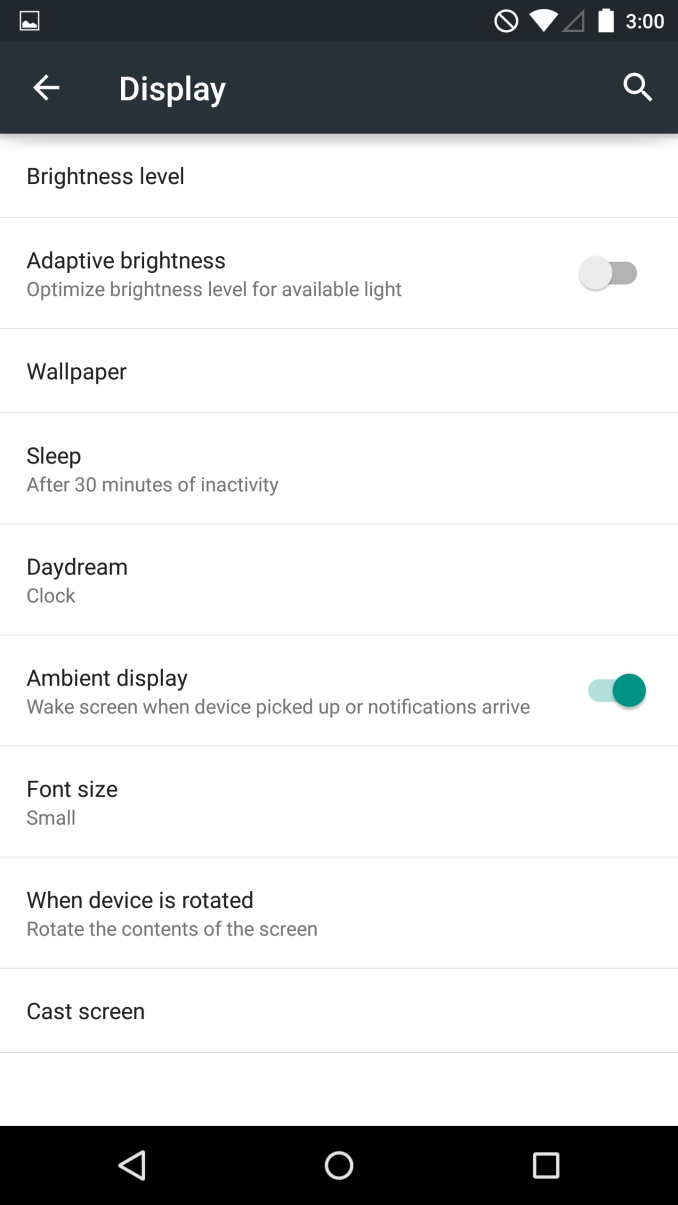The Nexus 6 Review
by Brandon Chester on November 12, 2014 1:00 PM ESTSoftware
The software on a smartphone is ultimately what defines whether or not it provides a good experience. Good hardware cannot save a device with poor software. The Nexus 6 comes with Google's latest iteration of Android, version 5.0 Lollipop. This is by far the biggest update the OS has seen in quite some time, with the last major visual overhaul occurring in 2011 with Android Ice Cream Sandwich. I plan to do a more in-depth look at Android Lollipop itself, but I do have some impressions of the operating system on the Nexus 6 specifically, as well as how it compares to Android Lollipop running on the Nexus 5. The most important question to answer about the software experience on the Nexus 6 is how well it takes advantage of the large display.
The most obvious starting point to look at is the launcher. While there are some visual changes from Android 4.4, the Google Now launcher is effectively the same in Android 5.0 as it was in 4.4 with regards to functionality. On the Nexus 6 it takes advantage of the larger display by adopting a 5x5 layout for applications and widgets on the home screens, and a 6x4 layout in the application drawer. The decision to only allow for four columns in the drawer seems to be more of an aesthetic one rather than a functional one, as it puts a greater amount of horizontal space between each icon. Google's decision to use a 5x5 layout on the home screen allows for a greater number of icons and widgets to be placed, but it also causes issues with many widgets that are non-resizeable and are fit to the typical 4 column width. This is something that will be fixed as time goes on and developers update their applications, and I support Google's decision to create some minor visual issues by allowing for more home screen space instead of simply making everything larger.
Unfortunately, some parts of Android Lollipop have a surprisingly low information density and this is made even more obvious on the large display. The main section of the Settings application is a particularly good example of this. As you can see above, even with the font size set to small there is a gratuitous amount of spacing between each label and the borders above and below it, which means that you are able to view far fewer sections on the screen at a single time. Fortunately this doesn't apply to the other parts of the application, but that also makes it seem inconsistently designed.
Above you can also see the toggle for Ambient display. This is a similar feature to Moto Display on the Moto X, where the display will turn on whenever a notification arrives or the phone is picked up. When this occurs, the lock screen is dimmer, with a black background and white used sparingly to conserve power. Thankfully, the extremely low display power consumption when this feature is in use means that it has no significant negative impact to battery life, and may actually improve it overall by eliminating the need to ramp up the CPU frequency and turn on the display fully whenever a notification arrives.
Providing a good video experience is something the Nexus 6 should excel at due to its massive display. Something that surprised me is that Google still has no actual video player application for Android, relying on playback through the photos application which has limited format support to say the least. At one time in the past the Play Movies & TV application had the ability to play videos stored locally, but now even that has been removed. To make matters worse, the version of MX Player on Google Play is incompatible with Android Lollipop and will not run. In my opinion, MX Player is the best video player on any mobile platform and not being able to test it would have been a great shame. Luckily, there is a version on the web which has been updated to run on Android Lollipop.
After finding a video player and sorting through any potential compatibility issues with the new OS, the video playback experience on the Nexus 6 is great in most cases. The contrast ratio of AMOLED displays makes some films look absolutely incredible, and the display calibration tends to not have a massive impact on live-action content. Animated content tends to use brighter and more highly saturated colors than what commonly appear in the real world, and so the over saturation does have a noticeable impact on how that looks on the Nexus 6 compared to a reference display. In terms of format support, it seems that video players don't yet have support for Qualcomm's HEVC decoder built into Snapdragon 805, and so any 1080p or 4K content encoded in High 10 Profile H.264 or HEVC brought the device to its knees. These are still fairly uncommon formats, and I doubt this will impact the experience for most users.
A good way to take advantage of a large display is by having special layouts in landscape mode. Apple did this with their iPhone 6 Plus by adding landscape support to Springboard, and by implementing dual-pane views in applications when displayed in landscape orientation. Samsung has also done this with some of their Touchwiz applications on the Galaxy Note 4. Unfortunately, Android Lollipop doesn't really have any special layouts made for the Nexus 6. While there are a couple of applications like Settings and Calculator that now have improved landscape views, these are perfectly usable on smaller devices like the Nexus 5 and are not unique to the Nexus 6. This makes it difficult to justify the sacrifice of one-handed usability to have such a large display, because the benefits are limited to just displaying a few more lines in Chrome or another row of icons. Google has obviously had to dedicate a lot of engineering resources to just getting Android Lollipop out the door, so it's possible that we'll see updates to enhance software on the Nexus 6, but as it is right now I'm wondering if Google possibly aimed a bit too high with the 5.96" screen size.
One last thing I would like to touch on is the performance of Android Lollipop on the Nexus 6. In this context, performance refers to the framerate of animations and any times where there are significant frame drops or freezes, which are commonly referred to as "jank". I am somewhat concerned because the Android Lollipop experience seems to have some areas with constantly low framerates or stuttering on the Nexus 6, despite all the promotion about the improved performance brought about by software optimization and the new ART runtime. However, what makes these issues interesting is that some of them do not exist on the Nexus 5 running the Android Lollipop preview, and I do not know the reason why. For the most part the experience is extremely smooth, smoother than Android has ever been. But certain applications like Calendar, Messages, and the notorious Google Play have animations that either frequently drop to 0fps which causes a visible stutter, or run not just below 60fps, but below 30fps, causing a sluggish animation. I am hopeful that these issues can be fixed with future software updates, but it's certainly surprising and concerning to see areas where the new device does not perform as well than the old one.















136 Comments
View All Comments
Brett Howse - Friday, November 14, 2014 - link
It's removed and I was "that reviewer".Apparently wifi scores are the single most critical piece of any smartphone review so this won't happen again.
jaysns - Thursday, November 13, 2014 - link
If you do the storage performance tests with the encryption enabled and disabled on the Nexus 5 you see a huge difference. As the 6 comes with this on by default and does not have a way to manually disable this (as far as I know) I'd love to see a follow up article by Anandtech on this issue and see if they can reproduce this and possibly find a way to disable it on the Nexus 6 and compare results. Based on what I've seen, if I can't disable it, or their storage is really just that slow, it would make a difference on my purchasing decision and possibly help other in the same boat. So please do a follow if you can :)Vizsla1986 - Thursday, November 13, 2014 - link
This particular review is an outlier against all the others, which are basically raves. Some of that is explicable - a lot of sites do pro forma reviews colored by a priori bias - but not all.Since I'm someone who purchased the original Moto X (loved it), upgraded to the Droid Turbo a couple of weeks ago (hated it. Returned it immediately) and then bought a 2nd Gen Moto X, a couple of comments based on actual experience.
1) Everyone needs to look at specs with a jaundiced eye. Sometimes they matter (storage) and sometimes it's contextual (RAM, for example. Depends on how system is used) but most of the time it's about throughput.
2) The Moto X was at least as fast, if not faster on throughput then every phone I compared it to, despite worse specs. A lot of that was display. 720 p is a lot easier on a system than 1080, but also not nearly as good. The 2nd gen. Moto X is *faster* in everyway, IMHO, than the Droid Turbo. I'd say that's also display-related, but the difference here is that the Turbo's screen (same as the Nexus 6) wasn't any better to my eyes than the Moto X 1080. YMMV, but one should carefully check this out. If you can't tell the difference (or much of one) consider the system impact.
2) The Moto X is clearly as fast (actually seems faster) as the Turbo despite an 801 chip compatred to the 805, and different clock speeds. Since I haven't had a chance to handle the Nexus 6, I can't compare, but I would urge anyone considering to pick the the two phones and compare throughput.
3) Clearly the Phablet Nexus 6 is a different experience than a smaller phone. I'm struck, though, that every single review I've read (maybe 6 of them now) has screamed themselves hoarse about how good the Nexus screen is. It's ok to be different, but *that* different? I'd recheck my report if I were the only person criticizing what everyone else thought the best thing about the phone. That's not different. That's idiosyncratic. On a phone this big, display quality is a simple thing to judge. There may be subtleties presenting on measurement, but one should be able at a glance to judge good or bad. I find this review suspect on that ground, never mind the measurements. FWIW, the DROID TURBO was bright enough. So is the Moto X. Why should the Nexus 6 be so different?
4) The price seems eminently reasonable, considering dimensions and specs. I understand why people want to see a cheaper Nexus alternative, but pricing needs to compared against delivered value, not just what one wished for.
5) Battery life. FWIW, I have never, ever, ever never needed to recharge any of the three Motorola phones I've had recently (Moto X Nos. 1 & 2 and the Droid Turbo)before going to bed. Once in a while I've drained to to a 10% remaining, but that would be it. The Turbo had an immense batterry (3900), so that's one explnation, but the 2nd Gen Motox X has only 2400 (from memory. Might be 2200). No problem. Motorola engineers are good at designing systems that get through the day on a charge. The Nexus has what? 3200? That ought to be good enough.
To be fair, everything depends on usage, and I'm not the hardest guy on batteries out there. I watch very little media (so no display drain), mostly calls, text and browsing. Someone else might have a much worse time of it. All I can attest to is my Moto phones have been spectacularly good (for me, anyway).
When I make a major purchase, I always check various vendors and compare thoroughly. If this review were in a purchase matrix I was running, I'd throw it out. It's always been a good policy for me to disregard the high and low bidders (or reviews) unless there was an exceptional circumstance. I don't see one here. I don't trust this review. I can't remember ever saying that about any other AnandTech report.
Graag - Sunday, November 16, 2014 - link
>This particular review is an outlier against all the others, which are basically raves. Some of that is explicable - a lot of sites do pro forma reviews colored by a priori bias - but not all.This is not true at all. Both the arstechnica and Verge reviews also found the Nexus 6 to be "meh".
randomlinh - Friday, November 28, 2014 - link
I dunno, most of the reviews seemed like a mixed bag to me, though leaning positive. But on the screen... AT is one of the only site to give tested numbers. Everyone has been a subjective "it looks great, just a little dim, but probably bright enough". That's not entirely helpful.The Note 4 gets a huge nod from displaymate which seems to mirror the results here: http://www.displaymate.com/Color_Accuracy_ShootOut...
gg555 - Thursday, November 13, 2014 - link
Sigh. No review of the noise cancellation. No mention of whether or not it has the four microphone noise cancellation found in the Moto X. No mention of whether it uses Motorola's CrystalTalk, Qualcomm's Fluence, Audience, or some other noise cancellation.My favorite part of the AnandTech cell phone reviews has totally died. And they were the only one doing it. What a shame.
davidc1 - Saturday, November 15, 2014 - link
Yes, yes, yes! Why no mention of audio quality, call quality, noise cancellation, etc, etc. Very disappointed.lanwellon - Thursday, November 13, 2014 - link
Hi, Brandon, I think you should point out that the reason why the Nexus 6 use the battery so quick is not all because of the bigger screen and more powerful CPU, please be noticed that in all the mobile phones you tested in this table, Nexus 6 is the only one running Android L, and Google enabled FDE (Full-Disk Encryption) function by default from Android 5.0. From my experience using Android 4.0 (Ice Cream Sandwich) FDE function, this can be a reason that cause the battery running down very fast. iPhone also enable FDE function by default, but it seems that Apple optimized it pretty well, so the impact to the battery usage is not that big.ol1bit - Friday, November 14, 2014 - link
There is always a segment of the population that buys Nexus devices because they are factory boxes. This is too make sure people who want a Samsung, HTC, etc. phone are not swayed by the low price to a Nexus device. Goggle doesn't want manufactures to die off, the price of a phone is not how they make their money.murphsp1 - Friday, November 14, 2014 - link
I have owned several Nexus devices and must say that the battery life numbers on this one look terribly disappointing ... and will only get worse over time. I just hope that more manufacturers start to understand that many would happily trade off an extra mm or two in thickness for an extra day of battery life. Now, fingers crossed that the Google Play edition of the Droid Turbo is coming ...